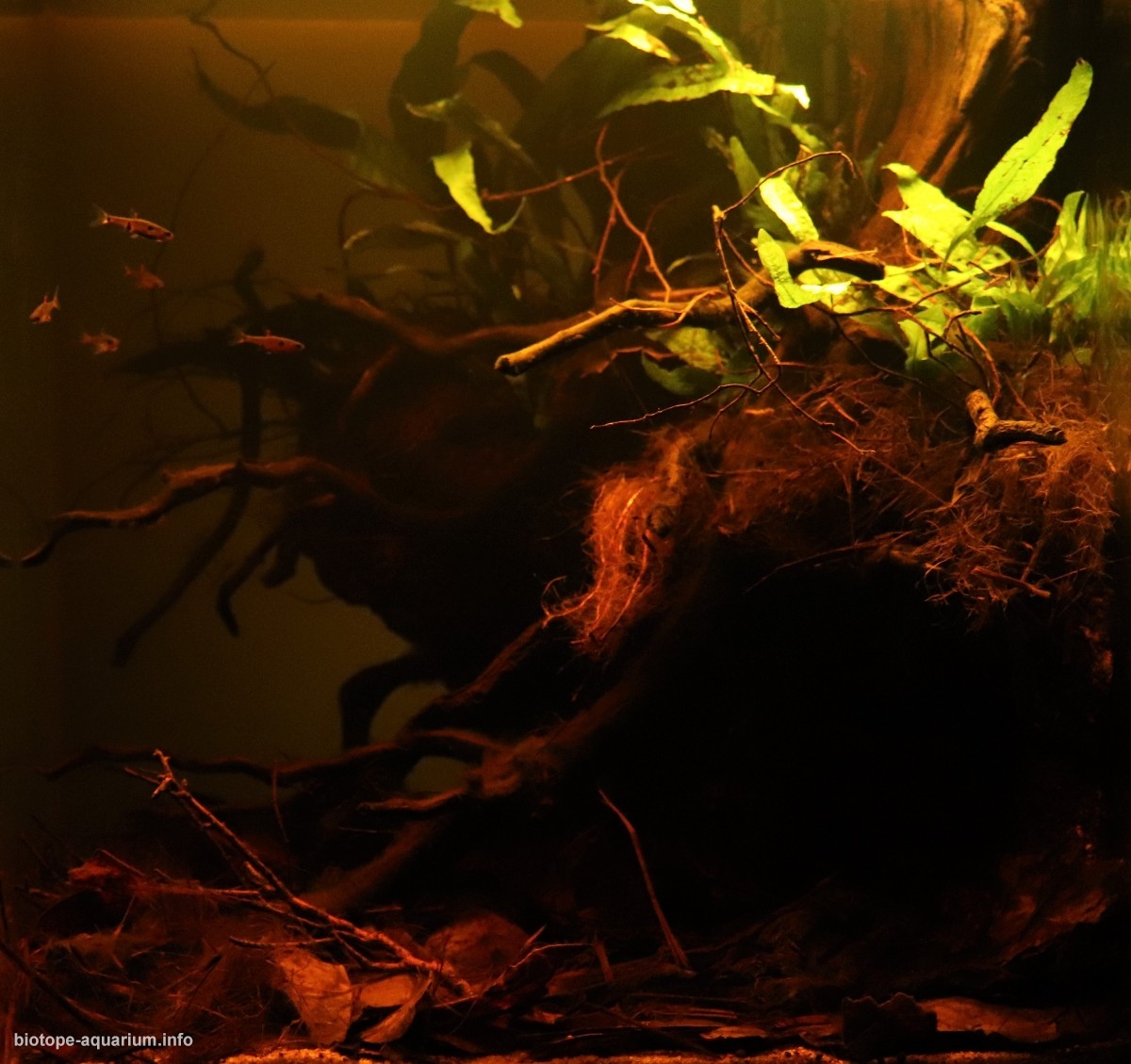Peat swamp forest, Johor, Malaysia
63th place in Biotope Aquarium Design Contest 2019
Japan. Rafael Takai Silveira

Volume: 32 L
Dimensions: 32x32x32 cm
List of fishes: Boraras maculatus (Dwarf Rasbora)
List of plants: Microsorum pteropus
Description of decorations: Substrate formed by a thin layer of sand, covered by leaves, branches, debris of trees and peat moss. Diy background composed of polyurethane and root resins and leaves. Origin root of malaysia and thailand imported by Kotobuki products for aquarium
Description of equipment: Filter System Eheim 2211 Canister type, heater set at 24 degrees Celsius, led light 5000 kelvins and 1400 lumens
Water parameters: Temperature 24 degrees Celsius
ph 5.0
Hardness 32
Additional info: Weekly water changes and parameter setting, cooling system, in case of water exceeding 28 degrees celsius
INFORMATION ABOUT BIOTOPE
Description of the area surrounding the biotope: Most of the lowland peatlands in Malaysia have developed along the coast, behind accreting mangrove coastlines, where sulphides in mangrove mud and water restrict bacterial activity, leading to the accumulation of organic matter as peat. Many peatlands which are now far inland developed along the former coastline such that some may be around 100 km inland such as the peat areas. The age of the oldest inland peat areas has been estimated as 4,000-5,000 years. The peatlands formed along the coast do not form an unbroken area, rather, they develop as individual units on the alluvial plains between rivers flowing to the sea. Peat domes are considered as discrete hydrological units, although they will also be influenced by the discharge and level of the rivers that surround them. Inundation by freshwater will only occur at the margins of the swamp where it borders the river or the freshwater swamp forest zone. Thus, the higher parts will only receive water in the form of rainfall. The natural vegetation of peatlands in Malaysia is generally peat swamp forest. There are a few peatland areas with a natural vegetation of sedges, grasses and shrubs, as a result of extended periods of inundation, especially where peat areas are found around water bodies. There is much variation in the species composition of peat swamp forest and this is mainly related to peat depth and hydrology affecting water table depth and nutrient content. Due to the dome-like structure of most of Malaysia’s peatlands, especially in Sarawak, several distinct peat swamp vegetation communities are found.
Description of the underwater landscape of the biotope: Peat swamp forests are one of the most unusual and harsh ecosystems in the tropical rainforest biome. These swamps derive their name from their substrate of peat consisting of plant detritus, which gradually release tannins and organic acids into poorly buffered water and contribute to its characteristically low pH. Peat swamps are generally referred as ‘black waters’, while waters originating from PSFs are highly acidic with pH values ranging from 3.6 to 5.9, tea-coloured when seen against transmitted light, and black when seen en masse via reflected light, generally, the acidity of black waters is due to the high concentrations of humic acids and other phenolic acids. The peat swamp forests of Johor, which were of staggering vastness in Peninsular Malaysia, are almost completely degraded. Peat swamp forests of considerable size in Peninsular Malaysia are now restricted to north Selangor, central Terengganu and Pahang .In Peninsular Malaysia, the fish fauna of the PSF of north Selangor is comparably well studied and recorded. The unique characteristics of black waters (dark colour, low dissolved oxygen and high acidity) led to an initial misinterpretation of habitat inhospitality and the conclusion that such habitat will sustain very poor faunal diversity. Peat swamp forests have unique water quality and as a result, fish species that can survive and breed in the black water environment are limited. Researchers have reported many species of fish in PSFs that are not found in other habitats
Description of the parameters of the habitat: Such environments characteristically contain very soft (negligible hardness), acidic (pH as low as 4.0) water and are often dimly-lit due to the forest canopy above.
List of fishes and invertebrates occurring in the nature biotope: Desmopuntius johorensis, Barbucca diabolica , Betta persephone, Betta splendens, Parosphromenus tweediei,
List of plants found in the nature biotope: Microsorum pteropus, Cryptocoryne, Ceratopteris thalictroides,
Threats to the ecology: Aquarium prepared in protest against the destruction of the areas of peat swamps in Malaysia, Johor the most affected state with deforestation and plantations is in a very difficult situation, maybe in the future there will be only memories or photos of documents.
Sources of information:
https://www.seriouslyfish.com/
